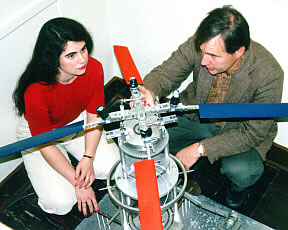College of EngineeringDepartment of Mechanical EngineeringResearchSystem Dynamics and Control
System Dynamics and Control
Nonlinear Systems Research Laboratory
Modeling of many mechanical systems such as asymmetric rotor bearing systems, helicopter blades, turbines, gear trains, spinning satellites, connecting rods in internal combustion engines, and structural elements subjected to in-plane periodic loads leads to a set of nonlinear differential equations with periodic coefficients. The principle aim of this proposed study is to develop a set of practical and efficient techniques that can be applied to a wide class of analysis and control problems encountered in nonlinear systems with periodically varying parameters.
Vibration and Environmental Testing Laboratory
This is a well-equipped facility that currently has all the necessary equipment to perform a wide variety of vibration and environmental testing. The major pieces of equipment that will be used for the proposed effort are
- A large capacity vibration exciter system. It has the capability of shaking up to 3000 lb (sinusoidially) and 2785 lb. (random), with a 3000 Hz useful frequency range. This system is equipped with a slip table so the test articles can be subjected to horizontal excitation without side-loading the shaker assembly.
- A compatible environmental chamber that will accommodate the vibration exciter so that test articles can be exposed to simultaneous temperature and vibration extremes. A photograph is shown in Fig. 10. The chamber can provide a temperature range of -100 oF to 350 o F.
- A variety of moderate capacity vibration exciters (50 lb capacity or less).
- A variety of data acquisition and measurement equipment, including a multi-channel data acquisition and analysis system and a variety of force and acceleration transducers.
Rotordynamics Research Laboratory
 The Rotordynamics Research Laboratory is dedicated to the study of vibration and control of rotating machinery. Modern equipment is available for studying shaft, disk and blade vibration phenomena, including a multiple channel signal analyzer and several PC based systems. Dynamic analysis codes, both commercial products and several written in-house, are used to simulated rotor systems and provide insight into experimentally observed behaviors.
The Rotordynamics Research Laboratory is dedicated to the study of vibration and control of rotating machinery. Modern equipment is available for studying shaft, disk and blade vibration phenomena, including a multiple channel signal analyzer and several PC based systems. Dynamic analysis codes, both commercial products and several written in-house, are used to simulated rotor systems and provide insight into experimentally observed behaviors.
Currently, the research is concerned specifically with two areas. The first is active magnetic bearings (AMB). Several bearings have been constructed in-house and are used to test control algorithms and study the dynamic behavior of magnetically supported rotor systems. Of particular interest is the investigation of concepts to reduce the complexity of magnetic bearing systems, such as designs without sensors, and to improve performance. A study of designs for auxiliary bearings to provide emergency support for AMB supported systems is also currently underway. The second area of research is the vibration control of rotorcraft. A small-scale test rig has been constructed and will be used in conjunction with simulation models to develop vibration control strategies for advanced rotorcraft designs, such as the V-22 Osprey. These research efforts have been funded through University support and by external agencies, including NASA (Langley, Lewis, and Marshall), AFOSR, and NSF.
GPS Vehicle Dynamics Lab
The GPS Vehicle Dynamics Laboratory focuses on the control and navigation of vehicles using GPS in conjunction with other sensors, such as Inertial Navigation System (INS) sensors. The laboratory has several research thrusts including: sensor fusion/integration, on-line system identification, adaptive and robust control algorithms, and vehicle state and parameter estimation. These research thrusts are focused towards vehicle dynamics and transportation, including heavy trucks, passenger cars, off-road vehicles, as well as autonomous and unmanned vehicles. The laboratory consists of various GPS receivers, Inertial Measurement Units (IMUs), an Infiniti G-35 loaned to us by Nissan, and access to an automatically steered John Deere tractor. Current projects include ultra-tight GPS/INS coupling (sponsored by the Army), study of vehicle rollover propensity (in collaboration with NHSTA), improved steering control of GPS guided farm tractors (sponsored by John Deere), vehicle and driver monitoring, and navigation and control of unmanned ground vehicles (UGVs).

